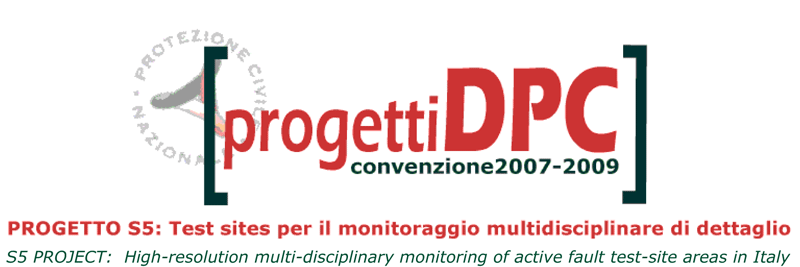The Project
| Il Progetto
Test site projects:
1. Alto-Tiberina Fault
2. Messina Strait
3. Irpinia Fault System
4. L'Aquila Fault System
Staff
1. Alto-Tiberina Fault
2. Messina Strait
3. Irpinia Fault System
4. L'Aquila Fault System
Database
Messina Strait
L'Aquila Fault System
Meetings
Publications and Conferences
Links
Scientific Reports and Deliverables

|
Coordinators: Lucia Margheriti and Aldo Zollo
S5 project is aimed at supporting the ongoing research on selected itlian test sites where
advanced monitoring geophysical networks are available or under construction.
The main general objective of the project is to improve the understanding of earthquake generation
processes in itly and to define the seismic rates in the three selected test sites by developing and
applying innovative methodologies to data-banks gathered by multi-disciplinary geophysical
networks.
The three selected test sites are:
- The Alto Tiberina Fault (ATF) test site, located inside the Northern Apennines mountain;
- The Messina Strait test site, which include the southernmost portion of itly and N-E of
Sicily: Calabro-Peloritni arc;
- The Irpinia fault system test site, located along the Southern Apenninic mountain belt.
Specific research objectives are:
- to promote an innovative and multidisciplinary research activity on the fault systems monitored
by three advanced seismological and geodetic networks in sites where further research
infrastructures will be potentially developed. The project integrate the ad-hoc monitoring networks
of the three sites with existing permanent networks in the regions (INGV seismic and geodedic
networks and acceleromentic data archived by
project S4);
- to implement analysis and modeling methodologies to be applied to geodetic and seismological
data acquired (in real-time and off-line) to gain a detailed picture of seismogenic sources and of the
crust structure at the three test sites. The
project S1 will benefit of the improvements gained at the
three test site in terms of improved earthquake locations and magnitude estimates and
improved estimates of seismogenic thickness (expecially for Task2 and Task3);
- to improve the knowledge of the active faults seismogenetic potential thanks to the high
resolution networks available in the test sites, in particular the geodetic networks in Task1 and
Task2 will derive the distribution of the tectonic strain rate and the rate of strain accumulation of
known active faults;
- to develop and apply new techniques (potentially real time) to gain information on the space-
temporal evolution of the fractures field in the monitored areas trough detailed earthquake location,
magnitude estimation and seismic anisotropy monitoring for early warning and shake-maps
applications (in a close cooperation between Task 3 and
project S3).
Deliverables of S5 project which have immediate impact and relevance for the Civil Protection Department (DPC) are :
Test site "ATF"
The seismic and geodetic networks deployed in this test site are permanent infrastructures
which will improve the monitoring capacity of the Umbria-Marche region;
the studies finalized for borehole installations are important for the integration of borehole
seismometers inside the itlian National Seismic Network;
HR and VHR stack sections and Vp images of the Tiber basin (500-1000 m deep) and of
the shallow fault zones (100-150 m deep) belonging to western splays of the ATF;
balanced geological sections, derived from depth converted seismic profiles at ATF test site
geological and geomorphological map of the High Tiber Valley from Perugia to Città di
Castello;
the refined geological and geophysical studies in this test site will help in to better defining
the earthquake generation potential of ATF.
Test site "Messina Strait"
The integration of ocean bottom seismographs (OBS) inside the itlian National Seismic
Network is one of the expected future development/ improvement;
the test of an acoustic link to transmit OBS data in near real-time is important for the
seismic monitoring and for an eventual tsunami warning system to be installed in the
region (see S3 project);
refined earthquakes locations in the Tyrrhenian and Ionian regions around Messina Strait
to define seismogenic structures;
the study of the deformation of the Calabro-peloritni arc using a multi-disciplinary
approach (geodetic deformation, fracture field defined through seismic anisotropy, seismic
strain evaluated by focal mechanisms) will furnish an interesting and detailed picture for the
ongoing scientific debate (see state of the art);
computation of the inter-seismic strain loading and possible deep geometry of the 1908
Messina fault from GPS and leveling data.
Test site "Irpinia fault system"
Development of methodologies for the monitoring and control of a seismic network through
real-time noise analysis and characterisation;
design of architecture and components of a real-time seismic monitoring infrastructure.
3D sub-surface velocity models integrating body and surface wave information, including
seismic discontinuities;
methods for the refined estimate of micro-earthquake source parameters (location,
magnitude, fault size and geometry);
characterisation and 4D monitoring of a system of active faults by the detailed analysis of
micro-earthquake activity (real-time and off-line methods);
implementation and test of a joint high frequency seismic and geodetic monitoring of active
fault systems.
Moreover in the final report at the closing of S5 project we will synthesize the main conclusions and
output of the various research activities summing and comparing the existing and new information
and knowledge in the three areas. More over we decided to dedicate part of the final project report
to the evaluation of project impact for Civil Protection, in particular for defining the future needs for
research and monitoring activities.
New Task 4: Test site "L'Aquila fault system"
A new task (Task 4,
Test site "L'Aquila fault system") has been added to the S5 project.
Its main objective is the understanding of the complex rupture processes related to the segmented normal faulting
processes occurred in Central itly during and after the Mw 6.3, April,6 2009 earthquake. This
project task will have a short time duration (less than 1 year) and a limited financial support due to
the late activation but it has a structure similar to the others.
This Task will include some of the ongoing monitoring and research activities and will integrate and
optimize available data and results, selected for their efficacy and prompt outcome.
[Top]
|

